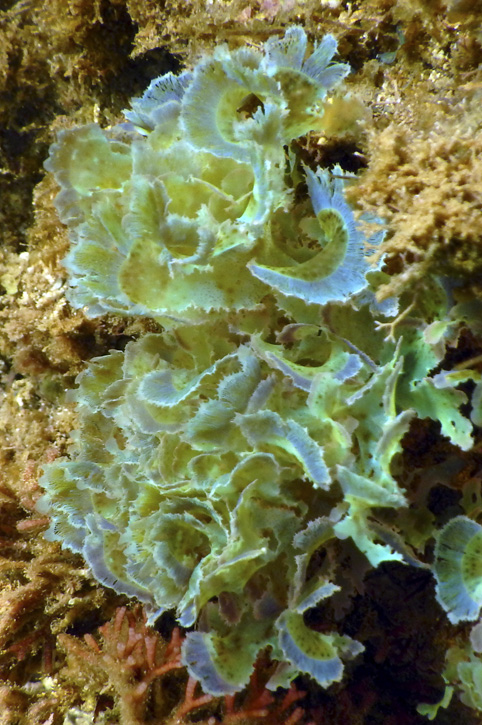Published in the Ocean Watch column, Honolulu Star-Advertiser © Susan Scott
July 22, 2013
While snorkeling on the North Shore last week, I found myself surrounded by an organism flashing so much bling I felt I was swimming through Tiffany’s.
The ocean was flat, calm and clear as drinking water, and when the sun emerged from a cloud, the reef lit up like a thousand opals. Iridescent blues and greens glowed in the early morning rays, their hues dazzling in the gentle surge.
 Martensia fragilis glows blue and green.
Martensia fragilis glows blue and green.
©2013 Susan Scott
I pulled out my camera to record the spectacle, but there was no need for stealth or haste. The entity couldn’t swim away if it wanted to because it was rooted to rocks. The organism was a seaweed.
Back home, I downloaded my photos and opened a guide book called “Hawaiian Reef Plants,” a University of Hawaii Sea Grant publication, to learn the name of this extraordinary plant. That turned out to be easier said than done.
Although the book is nicely color-coded with the four main seaweed categories — blue-green, red, green and brown — my lustrous blue-and-green jewel was neither a blue-green nor a green seaweed. It’s a red.
Blame the confusion on evolution.
The most primitive marine plants are the blue-green algae, appearing on Earth 3.5 billion years ago. It seems logical that the other three evolved from there, but no. A primitive animal ate the blue-green plant and, rather than digest it, took advantage of its ability to make carbs from sunlight. This animal, then, is the ancestor of the green and red seaweeds.
The browns are unrelated to the other three, having evolved separately. You can see how different brown seaweeds are by the size of some species, such as kelps that form entire forests.
Color categories don’t always match seaweed colors in real life. A marine plant’s appearance depends on its reproductive state, pigment-masking cells, local conditions and other variables.
Seaweeds might look simple, but when it comes to studying them, nothing is simple. Take the Latin name of my glorious, glowing seaweed, Martensia fragilis. That’s all it’s called. This plant has no common English or Hawaiian names.
Up to 2 inches tall, the seaweed is native to Hawaii. It also grows in the warm Indian, Pacific and Western Atlantic oceans from tide pools to waters 150 feet deep. In shallow water and bright sunshine, this light-reflecting seaweed is an astonishing work of nature — so lovely, it made me want to give it a hug.
I can’t hug a seaweed with its species name meaning “fragile,” but I can call it something that reflects its beauty. To me, Martensia fragilis will always be the opal weed. Swimming through that patch of it made me happy to be alive.